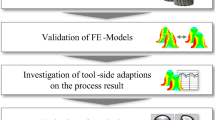Abstract
Cold extrusion is known as a metal forming process and used due to its dimensional precision. However, the process definition is obtained by empirical methods where experiments are performed previously and based on a “trial and error” method. To reduce costs, companies have been looking for the support of numerical simulation softwares with metal forming application. This study describes the investigation of the effect of different levels for prestressing of cold extrusion gear tool by using the software Simufact Forming. The dimensional deviations of the gear tooth were obtained from two numerical simulations and compared. The application of shrink rings for the prestressing of tooling was evaluated using two different methods to compare their efficiency. The first one is using conventional shrink rings with tool steel, while the second is the stripwinding concept developed by the company STRECON. To produce spur gears, the low carbon steel SAE 10B22 was used.
Similar content being viewed by others
References
Zhuang, W.; Han, X.; Hua, L.; Differences between traditional cold forging and cold orbital forging of a spur bevel gear, International Conference on the Technology of Plasticity, ICTP 2017, September 2017, Cambridge, UK
Hentz, E. A.; Schaeffer, L.; Knoll, P. K.; Influência da Curva de Escoamento na Simulação Computacional do Processo de Forjamento a Quente da Liga de Titânio Ti-6al-4v . Ciência & Engenharia, v. 16, n. 1/2, p. 53–59, jan. - dez. 2007
Clough, R.; The Finite Element Method in Place Stress Analysis. In: Anais da 2. Conference on Electronic Method. International Computation.” 1960, Pittsburgh: American Society of Civil Engineers. p. 345–378
Turner, M.; Clough, R.; Martin, H.; Topp, I.; Stiffness and deflection analysis of complex structures. J Aeronautical Sci, v. 23, n. 9. p. 805–821, setembro 1956, 823
Raddad, B.; Kocanda, A.; On the strength criteria for high stressed ring-shaped dies, in: Proceedings of the fourth international conference on Technology of Plasticity, 1993, pp. 5–9
Lee YS, Lee JH (2004) Finite element modeling approaches to the accurate dimensional prediction for a cold-forged part. J Eng Manuf 218:1709–1722
Hollomon, J. H.; Tensile deformation. Transactions—American Institute of Mining and Metallurgical Engineers, New York, v. 126, p. 268–290, 1945
ASM HANDBOOK; Failure Analysis and Prevention; ASM International, vol. 11, 2002
Drozda, T. J.; Wick, C., Tool and manufacturing engineers’ handbook . 4. Ed. Dearborn: Society of Manufacturing Engineers, 5 v, 1983
Hensel, A, Spittel, T.; Kraft- und Arbeitsbedarf bildsamer Formgebungsverfahren, Leipzig: VEB Deutscher Verlag fur Grundstoffindustrie, 1978, p. 200–202
Groenbaeck J, Nielsen EB (1994) New developments in the design of high performance, stripwound cold forging tools. J Mater Process Technol 46:87–97
Lund, E.; Andresen, H.; Jepsen, C.; Tool optimization by means of effective prestressing system, STRECON A/S, Sonderborg, Denmark, 2015
Osakada, K.: Cold forging in Japan, Presentation at the 40th International Cold Forging Group, Plenary Meeting, Padova, Italy, September 2007
Lee YS, Lee JH, Ishikawa T (2002) Analysis of the elastic characteristics at forging die for the cold forged dimensional accuracy. J Mater Process Technol 130/131:532–539
Lee YS, Lee JH, Choi JU, Ishikawa T (2002) Experimental and analytical evaluation for elastic deformation behaviors of cold forging tool. J Mater Process Technol 127:73–82
Groenbaek, J.; Hinsel, C.; Improved Fatigue Life and Accuracy of Precision Forging Dies by Advanced Stripwound Prestressing System, SME Clinic on Precision Forging Technology, Columbus, Ohio, USA, Nov 10, 2000
Zhang, Y.; Huang, J.; Lin, X.; Quanshui, F.; Numerical simulation analysis on cold closed-die forging of differential satellite gear in car, materials science forum, Vols 575-578 (2008) pp 517–524
Kang JH, Lee KO, Je JS, Kang SS (2007) Spur gear forging tool manufacturing method considering elastic deformation due to shrink fitting. J Mater Process Technol 187-188:14–18
Acknowledgements
The authors gratefully acknowledge the support of ZEN S.A. Industria Metalurgica that made the software Simufact Forming available and data acquisition by practical tests with tooling and forging presses, and the Metal Forming Institute of Stuttgart University for the experiments carried out with the raw material which was scope of this research.
Author information
Authors and Affiliations
Corresponding author
Ethics declarations
Conflict of interest
The authors declare that they have no conflict of interest.
Rights and permissions
About this article
Cite this article
Silveira, F.D., Schaeffer, L. Evaluation of different levels of prestressing for cold forging tools by numerical simulation analysis. Int J Adv Manuf Technol 98, 2487–2495 (2018). https://doi.org/10.1007/s00170-018-2351-9
Received:
Accepted:
Published:
Issue Date:
DOI: https://doi.org/10.1007/s00170-018-2351-9




